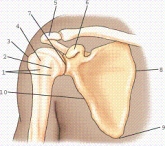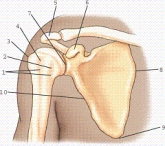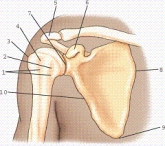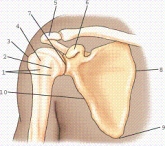A) Clements modification
B) Neer method
C) Fisk modification
D) Hobbs modification
E) Garth method
F) Grashey method
H) A) and E)
Correct Answer

verified
Correct Answer
verified
Multiple Choice
Which view and projection of the proximal humerus is represented in the figure?

A) External rotation, anteroposterior (AP) projection
B) Neutral rotation, AP projection
C) Internal rotation, AP projection
D) External rotation, lateral projection
F) A) and D)
Correct Answer

verified
Correct Answer
verified
True/False
Part 3 refers to the greater tubercle.

B) False
Correct Answer

verified
Correct Answer
verified
Multiple Choice
The AP humerus requires that the humeral epicondyles are _____ to the IR.
A) set at a 45° angle
B) parallel
C) perpendicular
D) slightly oblique
F) A) and C)
Correct Answer

verified
Correct Answer
verified
Multiple Choice
MATCHING Select the correct method name to match each shoulder projection.(Use each choice only once.) -Posterior oblique,glenoid cavity projection
A) Clements modification
B) Neer method
C) Fisk modification
D) Hobbs modification
E) Garth method
F) Grashey method
H) B) and E)
Correct Answer

verified
Correct Answer
verified
Multiple Choice
Part 5 refers to the:

A) coracoid process.
B) superior border of scapula.
C) lateral angle of scapula.
D) none of the above.
F) All of the above
Correct Answer

verified
Correct Answer
verified
Multiple Choice
A patient comes to the emergency department (ED) with a possible right AC joint separation.Right clavicle and AC joint exams are ordered.The clavicle is taken first,and a small linear fracture of the midshaft of the clavicle is discovered.What should the technologist do in this situation?
A) Perform the weight-bearing phase as ordered.
B) Reduce the amount of weight that would normally be given to the patient and perform the weight-bearing study.
C) Consult with the ED physician before continuing with the AC joint study.
D) Slowly give the patient more weight to hold until he begins to complain and then complete the AC joint study.
F) A) and C)
Correct Answer

verified
Correct Answer
verified
Multiple Choice
Part 3 refers to the:

A) scapulohumeral joint.
B) glenohumeral joint.
C) glenoid cavity or fossa.
D) all of the above.
F) A) and C)
Correct Answer

verified
Correct Answer
verified
True/False
An orthostatic (breathing)technique can be performed for the AP projection of the scapula.
B) False
Correct Answer

verified
Correct Answer
verified
Multiple Choice
Which of the following shoulder positions is considered a trauma projection (can be performed safely for a possible fracture or dislocation) ?
A) AP apical oblique axial (Garth method) projection
B) Inferosuperior axial (Clements modification) projection
C) AP projection-internal rotation
D) None of the above
F) None of the above
Correct Answer

verified
Correct Answer
verified
Multiple Choice
Which AP projection of the shoulder and proximal humerus is created by placing the affected palm of the hand facing inward toward the thigh?
A) Internal rotation
B) Neutral rotation
C) External rotation
D) AP axial
F) A) and D)
Correct Answer

verified
Correct Answer
verified
Multiple Choice
A patient enters the ED with a midshaft humeral fracture.The AP projection taken on the cart demonstrates another fracture near the surgical neck of the humerus.The patient is unable to stand or rotate the humerus because of the extent of the trauma.What other projection should be taken for this patient?
A) Scapular Y lateral-AP oblique projection
B) Apical oblique projection
C) Horizontal beam transthoracic lateral projection for humerus
D) Rotational lateral projection for humerus
F) B) and C)
Correct Answer

verified
Correct Answer
verified
True/False
PA transaxillary (Hobbs modification)requires a 5° to 15° CR cephalic angle.
B) False
Correct Answer

verified
Correct Answer
verified
True/False
For a Grashey method projection of the shoulder,the CR is centered to the acromion.
B) False
Correct Answer

verified
Correct Answer
verified
Multiple Choice
MATCHING Select the correct method name to match each shoulder projection.(Use each choice only once.) -PA transaxillary projection
A) Clements modification
B) Neer method
C) Fisk modification
D) Hobbs modification
E) Garth method
F) Grashey method
H) A) and C)
Correct Answer

verified
Correct Answer
verified
Showing 61 - 75 of 75
Related Exams